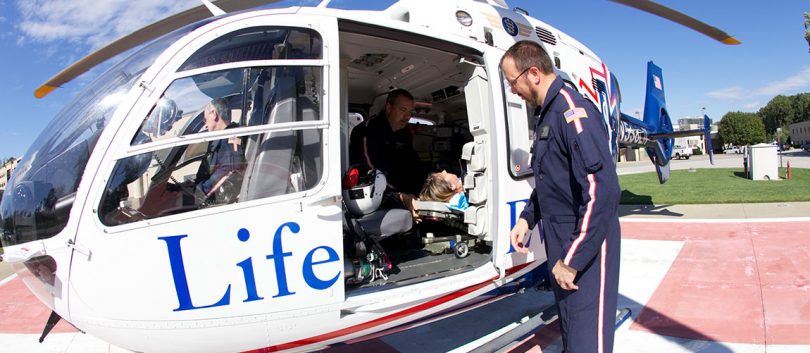Whipping the air into a frenzy, the white, blue and red helicopter gently touches down on the tarmac at the Middle Peninsula Regional Airport on a bright, sunny afternoon.
After taking a few minutes to shut down, out hops the three-person crew—pilot, nurse and paramedic—who pull off their helmets as they head into their office to await their next call.
They don’t have to wait long. About a half-hour later, after the pilot has refueled the helicopter and the nurse and medic have sat down to grab some lunch, the radio crackles.
The third call of the day beckons LifeEvac III to Riverside Walter Reed Hospital in Gloucester County, Virginia, to transport a 57-year-old cancer patient to Sentara CarePlex Hospital in Hampton, Virginia.
“They say go,” says flight nurse and medical base supervisor Bev Harris, pushing away her salad. “We say OK.”
The call is a bit more sedate than an earlier one, during which the crew landed in a New Kent County, Virginia, field to pick up a gunshot victim. Another flight was to transport a heart attack patient.
It’s all in a day’s work for this ambulance in the sky.
LifeEvac III has been working in Hampton Roads since June 2006, often to the surprise of medical folks used to Sentara’s Nightingale being the only emergency medical helicopter in the area. Although it’s considered a community-based helicopter and not a hospital-based one, LifeEvac III has partnerships with both the Riverside and Bon Secours health systems.
Based at the Middle Peninsula Regional Airport just outside of West Point, Virginia, LifeEvac III’s primary service area is a 120-mile radius around West Point. It answers calls throughout Hampton Roads, the Northern Neck Middle Peninsula and the Eastern Shore, but has flown to North Carolina, Maryland and Washington, D.C., on occasion. The crew considers its service area the community—if the weather is right for flying, they’ll respond.
“If you need us, we’re here,” says lead pilot Dave Givens. “If we’re available, we’re coming.”
The crew also tries to get to know their community as much as possible, holding open houses at the airport, visiting schools and offering free continuing education classes to EMS providers.
Since the program began, LifeEvac III has remained busy, averaging about 450 flights a year. This year, in just its 8th year of existence, it was named the 2014 Outstanding EMS Agency by the Peninsula Emergency Medical Services Council, which facilitates regional cooperation among all the emergency medical services in the area.
LifeEvac III is one of two LifeEvac medical helicopters in Virginia; the other is based in Petersburg, just south of Richmond, “and is affiliated with the VCU Health System.” The helicopters are owned and operated by Englewood Colorado-based Air Methods, the largest provider of air medical emergency transport in the United States, with some 450 aircraft.
In West Point, the program operates with a full-time staff of 14—four pilots, four paramedics, four nurses and two mechanics, all working on rotating schedules. A crew of three flies on the EC-135 helicopter, which can carry one patient (or a patient and family member if the weight limit allows it), and cruises at speeds up to 150 mph.
The critical care flight nurse-medic team is prepared to handle virtually any patient situation, including trauma scenes, critical-care transports between hospitals, and high-risk obstetrical transports. Because they’re authorized to carry and use drugs found in emergency rooms and intensive-care units, the medical crew can handle many procedures in the air, if need be. Bottom line: They want the patients to be better off when they leave them than when they’re picked up.
And the thank yous often come in, each letter tucked into one of several scrapbooks the staff keeps. Patients have sought out the crew long after their flights, some showing up with cakes. One letter that’s especially dear to Harris’s heart still chokes her up.
It’s those moments—the getting to make a difference in someone’s life, perhaps helping to save a life—that mean much more than any award the crew could ever get.
“That’s worth all the midnight runs and the crappy weather,” Givens says. “To experience that is greater than Christmas.”



